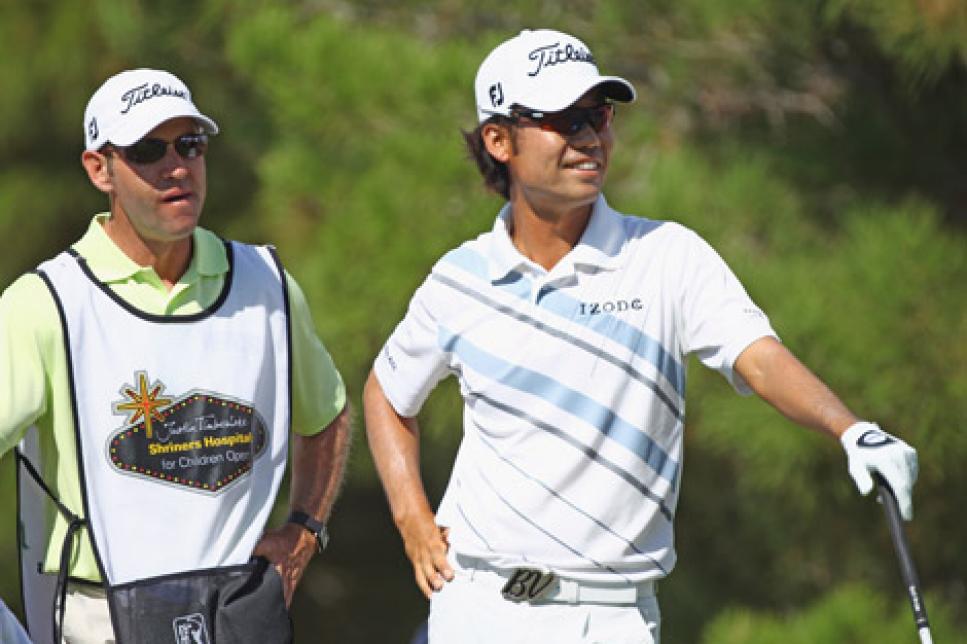The Loop
Monday Swing Analysis: Don't try Kevin Na's 'whiff'
*Roger Schiffman
Managing Editor
Golf Digest Twitter
Editor's note: Every Monday, PGA professional Kevin Hinton examines the game of a recent tour winner and tells you what you can learn. A Golf Digest Best Young Teacher, Kevin is the Director of Instruction at Piping Rock Golf Club, Locust Valley, N.Y., and is a Lead Master Instructor for the Jim McLean Golf School at Doral Resort & Spa. He also teaches at Drive 495 in New York. He has seen thousands of swings and has helped golfers of all abilities, from rank beginners to tour players. This week, Kevin takes a look at Kevin Na's wild "whiff" on his way to winning the Justin Timberlake Shriners Hospitals for Children Open on Sunday. Hinton also tells you how to commit to your next swing with a preshot routine.
__
Kevin Hinton: __The "Brady Tuck Rule" set the tone for the New England Patriots run of NFL Championships, the "Steve Bartman Rule" for fan interference kept Chicago Cubs fans awaiting their long coveted World Series title, and after Kevin Na's unique preshot routine during the final round of the Justin Timberlake event, there may soon be a "Na Whiff Rule" that could change the landscape of golf as we know it.
Check out this video, then read below...
No longer will the uncommitted golfer be allowed to do the "Tiger" balk in mid-downswing, golf umpires will be strategically positioned throughout the course, and fellow competitors will be allowed to throw their red challenge flag twice per round. If all goes well, we could probably get the average pace of a round up to six hours if we try hard enough.
In all seriousness, Na's "whiff" was one of the more interesting things I have seen on the PGA Tour in quite some time. While I'm certain someone in the USGA is reviewing the definition of an "attempted stroke," it got me thinking of what the characteristics of a good preshot routine are. Here are the basics to a good routine...and none of them include intentionally whiffing!
Part I: Five steps to collecting information
--Yardage
--Wind direction
--Uphill or downhill
--Analyze the lie
--Analyze where the trouble is...this influences the final target you pick__
__
These five steps shouldn't take very long, just a few seconds. An experienced golfer does this very quickly and almost instinctively. The goal of Part 1 is to assess all of the variables that determine how long the shot will actually play and to decide on a target. Then pick the appropriate club and begin Part II.

*What are you waiting for? Once you have a routine,
there's no reason to stand around*. (Photo by Getty Images)
__Part II: Establish your target line.
__
At some point you must stand behind the ball and line yourself with your target before you walk into the shot. Practice swings are completely optional. Some tour players take multiple swings, some rehearse a drill, some do not take one at all. However, I highly recommend you take a few on short-game shots. Getting a feel for the ground and controlling the distance is essential.__
Then...
__Walk into the ball at a 90-degree angle to your target line. Doing this will make it much easier to set up squarely to the ball.
Adjust your feet and club placement. This varies greatly among PGA Tour players. The one commonality is that they do the same thing every time. That is the key. The two most popular ways are (1) Setting the right foot and the clubface at the same time, then bringing in the left foot and adjusting the stance, or (2) Aiming the clubface while the feet are positioned together. If you want the ball in the middle of your stance, take even steps. If you are hitting a driver, take a small step with your front foot, a large step with your back foot. This will establish a wider stance with the ball in the front.
Don't forget to waggle. This is an essential part to golf and is often undertaught. All great players make some movements prior to hitting the ball. It can be very personal. There really isn't a right or wrong way to waggle. They also typically jostle their feet slightly. In general, the movements are small and don't affect their setup. It's also a key to avoiding tension.
Glance at the ball, stare at the target. Teaching in many golf schools with Jim McLean, I've heard him say this hundreds of times. It is very important. The ball isn't going anywhere...use your eyes to focus on your target and to visualize the shot
One last look, then pull the trigger. Tour players have this choreographed to the last detail. They also practice it. If you watch closely, you'll likely see them taking the same number of looks on all shots, and beginning their swing with the same timing from their last look. The best routines work like clockwork
This all sounds like it could take a long time, but for the most part the opposite is true. Amateurs often hit certain shots very quickly, then stand over the ball forever on others. Make your goal to have Part II of your routine take no more than 25-30 seconds. Timing it and trying to repeat it is a great exercise. The shorter version you should remember on the course is...
__

.jpg)